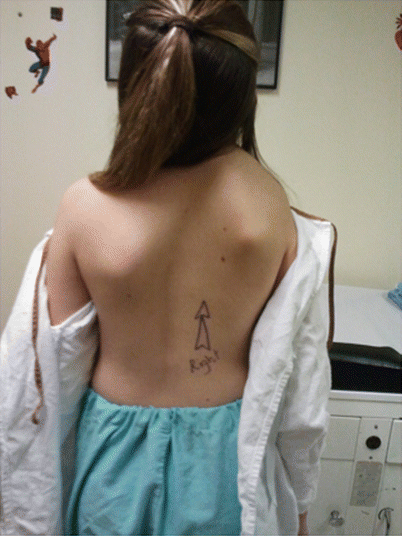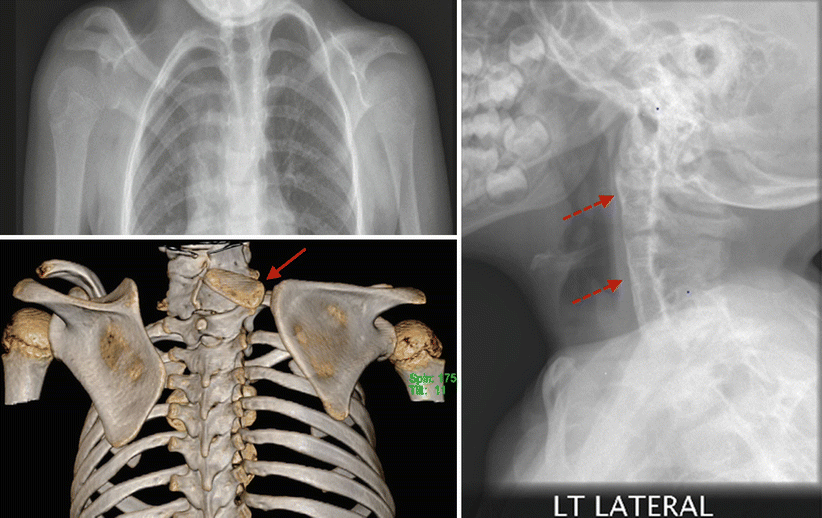Grade
Description
Grade I (very mild)
Shoulder joints are level and the deformity is invisible when the patient is dressed
Grade II (mild)
Shoulder joints are level or almost level but the deformity is visible when the patient is dressed as a lump in the web of the neck
Grade III (moderate)
Shoulder joint is elevated 2–5 cm and the deformity is easily visible
Grade IV (severe)
Shoulder is much elevated with the superior angle of the scapula near the occiput, with or without neck webbing

Fig. 30.1
Clinical photograph of a child with Sprengel shoulder

Fig. 30.2
Radiological findings in Sprengel shoulder. Plain radiographs and 3D CT-scan of a child with a right Sprengel shoulder. The right scapula is high riding. Cervical vertebrae fusion (dashed arrows) and omovertberal bony connection (solid arrow)
Treatment
The decision of treatment of Sprengel deformity depends on several factors such as the cosmetic appearance (Cavendish grade – Table 30.1), functional shoulder impairment, presence of other anomalies, unilateral or bilateral deformities and the age of the patient.
Nonsurgical Treatment
Non-surgical treatment has been recommended for patients with mild Sprengel deformity. Non-surgical treatment includes modalities such as physiotherapy to improve the shoulder range of motion and prevent any torticollis. In the classic Cavendish study [10], different grades of Sprengel deformity were treated non-surgically. The study concluded that very mild (grade I) Sprengel deformity patients do not confer a worthwhile benefit with surgery. However, 34 of the 66 (52 %) patients treated non-surgically in the study were Cavendish grade II, III and IV Sprengel deformities [10].
Farsetti et al. [12] reported the long-term follow-up of 15 patients with Sprengel deformity treated non-surgically. At a mean follow-up of 26 years (range: 10–55 years), the final mean shoulder abduction was 125° (range: 90°–160°) and did not change over time. In addition, all patients were Cavendish grade I and II at final follow-up and remained in their same grade over time and were satisfied with the cosmetic outcome.
Surgical Treatment
Multiple surgical procedures have been described for the treatment of Sprengel deformity. The aim of surgical procedures is to lower the position of the scapula with respect to the chest wall with resection of the omovertebral connection if present. Soft tissue surgical procedures described in the literature include the release of either the muscular insertions at the medial border of the scapula or the corresponding origins with a relocation of the scapula inferiorly. Ross and Cruess [11] reported better results in patients whom undergo scapula relocation surgery compared to scapula excision in terms of both shoulder function and cosmesis.
The main goals of surgery for Sprengel deformity are to improve cosmetic appearance and shoulder function. Some authors believe that the cosmetic outcome is more important than the functional outcome for the majority of surgical procedures. The results of surgical treatment can be complicated by malformations and contractures of the soft tissue. Lowering the scapula to the level of the normal side is not advocated because of the increased risk of brachial plexus palsy. The optimal age for surgery remains controversial but has been suggested to be between 4 and 6 years old [1, 6, 13].
The most common surgical treatment for Sprengel deformity are the Woodward and Green procedures. A third category includes scapula osteotomies.
Woodward Procedure
The Woodward procedure was first described in 1961 and is stated more frequently in the literature than any other surgical procedure for Sprengel deformity [14]. In the Woodward procedure, the trapezius, rhomboid and levator scapulae muscles are detached from their origin along the spinous processes. The scapula is lowered and derotated with reattachment of the muscle to the spinous processes in a more inferior position. The muscles attached on the superior and medial borders of the scapula are reflected extraperiosteally. The procedure is accompanied with excision of any omovertebral connection present and a clavicle osteotomy if required.
Walstra et al. [15] reviewed seven patients (eight shoulders) who underwent the Woodward procedure and reported the long-term results at three different time intervals. The mean age at the time of surgery was 8.75 years (range: 3.4–15.1 years). At a mean follow-up of 13.5 years (range: 8–26 years), the mean shoulder abduction improved by 56° (range: 95°–175°). Cosmesis improved by at least one grade on the Cavendish scale in all patients. Other outcome measures such as the Constant, the DASH (Disabilities of the Arm, Shoulder and Hand) scores and simple shoulder test were also recorded. No long-term complications occurred in this case series. The authors concluded that the Woodward procedure is effective in improving shoulder function and cosmetic appearance in patients with Sprengel deformity in the long-term.
Similarly, Siu et al. [16] reviewed eight patients (nine shoulders) who underwent the Woodward procedure. At a mean follow-up of 113 months (range: 78–140 months), the mean shoulder abduction was 157° (range: 125°–180°). Cosmesis improved significantly on the Cavendish scale and all patients were satisfied with the results. The Constant score was also recorded for the patients. No complications were noted in this case series.
Other case series in the literature report the results of the Woodward procedure with satisfactory improvement in the mean shoulder abduction and cosmetic appearance according to the Cavendish grade [1, 6].
Modifications of the Woodward Procedure
Borges et al.
Borges et al. [13] modified the original Woodward procedure by adding an excision of the medial border of the scapula and resection of the supraspinatous portion of the scapula. Borges et al. [13] reviewed the long-term results of 15 patients (16 shoulders) in their original study who underwent the modified Woodward procedure. The mean pre-operative shoulder abduction was 115° (range: 90°–160°). At a mean follow-up of 8 years (range: 3.2–15 years), the mean shoulder abduction was 150° (range: 100°–180°). Cosmesis improved by at least one grade on the Cavendish scale in all patients. One patient developed a temporary brachial plexus palsy that resolved 3 months after a clavicular osteotomy. Borges et al. [13] concluded that the modified Woodward procedure correction did not change with growth of the patient and was maintained beyond skeletal maturity.
Ahmad
Ahmad [17] modified the Woodward procedure by combining the lowering of the scapula with correction of the varus position of the glenoid by placement of an absorbable suture through the superomedial portion of the scapula. This modification was associated with immediate post-operative range of motion of the shoulder in 11 patients (15 shoulders). At a mean follow-up of 36.5 months, the mean shoulder abduction was 139° (range: 90°–170°) translating into a gain of 49° of shoulder abduction. Cosmetic appearance improved in all patients. Three patients developed winging of the scapula post-operatively. The author concluded that this double correction results in an improvement of shoulder function and cosmesis.
Green Procedure
The Green procedure is one of the classic surgical procedures for the treatment of Sprengel deformity [18]. In the Green procedure, the muscles on the medial border of the scapula are detached from their insertions. The trapezius muscle is elevated extraperiosteally and reflected medially. The underlying medial and superior scapular musculature (latissimus dorsi, serratus anterior, levator scapulae, supraspinatus and rhomboids) are resected extraperiosteally. The supraspinatus fossa is excised to avoid damage to the neurovascular bundle. The omovertebral connection when present is also excised. The scapula is freed and mobilized distally to the appropriate level. Once the scapula is in the desired position, the muscle insertions are re-attached to the scapula lengthening each muscle as required. In the Green procedure, the scapula is both lowered and rotated. Muscle insertion is modified distally rather than proximally which provides better biomechanical outcome [19].
Modifications of the Green Procedure
Leibovic et al.
Leibovic et al. [20] modified the Green procedure by repositioning the scapula into a pocket that was developed in the latissimus dorsi. Leibovic et al. [20] reviewed 14 patients (16 shoulders) in their original study. The mean pre-operative shoulder abduction was 91° (range: 60°–120°). At a mean follow-up of 6.5 years (range: 3–14 years), the mean shoulder abduction was 148° (range: 100°–180°). Leibovic et al. [20] concluded that repositioning of the scapula in a pocket in latissimus dorsi did result in rotation of the scapula in the short-term but improvement was not maintained.
Stay updated, free articles. Join our Telegram channel

Full access? Get Clinical Tree







